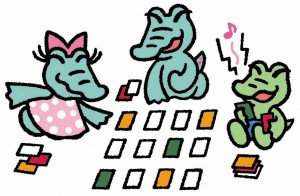conference curriculum EFL eikaiwa elllo ES ETJ expectations extensive listening extensive reading high school Japanese junior high school Language learning online resources oxford owl Oxford Reading Tree phonics popjisyo presentations renshuu reviews rikai self-study teaching technology TED university video
by sendaiben
leave a comment
Annotated list of websites from the “SRS, RSS, LMS: Online Tools to Boost Learner Efficiency” presentations
Hi everyone
A friend from Sendai reminded me that I promised to post the list of websites from my presentation on the blog. Here it is:
Anki is a spaced-repetition program
elllo.org is an amazing listening resource: over 1200 short conversations with transcripts
EnglishCentral.com has short videos with interactive subtitles as well as vocab and pronunciation practice
Facebook needs no introduction
Google search settings have some interesting tools, like reading level
Google translate is partially useful
iTunesUniversity great content for advanced students and teachers can now use it to show their classes
Network (Oxford University Press textbook) new series based around social media
OxfordOwl incredible resources including Oxford Reading Tree ebooks with sound
pikifriends a closed social network for junior high schools
popjisyo.com amazing resource for reading online content
readthekanji.com a simple (paid) system for learning kanji
renshuu.org a very powerful site for learning kanji and vocabulary -freemium but most of it is free
rikaikun for Chrome/rikaichan browser extension Firefox gives popup translations within the browser
skype for video calls
starfall.com phonics and reading practice for children
TED.com great content for teachers and advanced learners
youtube.com you know this
Hope you find something useful in there.
conference curriculum EFL expectations language courses Language learning presentations teaching university
by sendaiben
leave a comment
Building Effective University Language Programs
I’m quite proud of this one. Here’s my talk from the seminar yesterday, entitled “Building Effective Language Instruction”. It’s actually about how to think about university language programs, what they should include and, more importantly, not include.
The outline is below for anyone who doesn’t like videos.
Introduction: the world has changed
Students, employers, and most importantly, language learning techniques have all changed in the new millenium.
What is effective foreign language instruction?
What are the desired outcomes of foreign language instruction? How can they be achieved?
Proficiency, independence
Things students don’t need
Foreign language instruction often includes extraneous material or goals that reduce its effectiveness: technical and social skills
A model program
What would an ideal foreign language program look like atTohokuUniversity? How could it be implemented? Blended learning, serve different types of students, lifetime learning
How to measure results
How should language learning outcomes be measured? How can the effectiveness of a program be judged? Not just standard language tests
Be Nice curriculum EFL eikaiwa ES expectations junior high school kids language courses Language learning school management Teach Like a Champion teaching
by sendaiben
2 comments
Zero tolerance
I’m normally a fairly laid-back guy, and I am probably a ‘nice’ teacher. I see my role as being a coach, someone who can provide training, encouragement, and advice to my students so they can learn the skills of English. At university, I set clear (high) expectations and show my students how to meet them.
In children’s classes though, something wasn’t right.
I’ve been reading a lot recently. Kindle on a phone makes reading anywhere, anytime a breeze. I think I have probably more than doubled the number of books I read since I got it.
Two standouts: Teach like a Champion, which I have talked about before, and more recently Work Hard, Be Nice (about the Knowledge Is Power Program in the US).
Both of them talk about high-energy, high-expectation, zero-tolerance classrooms. I don’t have big problems with discipline in my classes, but they could definitely be better, and perhaps the techniques in these books could help me…
I want my classes to be exciting, the students to be motivated and enthusiastic, and the results to be spectacular. I have some students who end up amazing users of English, and some that don’t, but I think it is possible to increase the numbers of those that do.
Recently I have been experimenting with a two-pronged approach:
1. keep the students busy with achievable, interesting activities
2. firmly jump on any form of undesired student behaviour immediately
Examples of undesirable behaviour: hitting, verbal attacks on teachers or other students, moving around without permission, talking about things not germane to the lesson, playing with pencils or other objects, not singing, not participating in speaking activities, not doing homework, not following instructions, etc.
So far it is going really well. I think students like to know what is expected of them and what they should be doing. Being firm in enforcing the rules allows the students who are into the lessons to enjoy them more, and makes life easier for the teacher. The flipside, of course, as alluded to in number 1 above, is that it is also essential to keep students challenged and busy in class.
I am going to continue with my ‘firm teacher’ experiment and see how the students progress. I’m very excited to see how the classes go over the next few months until March.
curriculum EFL eikaiwa ES expectations kids language courses
by sendaiben
leave a comment
Pair vocabulary activity
Class: children’s eikaiwa
Students: four seven-year-olds (experience of learning English 6 months-2 years)
I was teaching a group of first year elementary school age students a couple of days ago, and stumbled upon a wonderful activity that really gave me a boost.
We were practicing insect names again (for the third time), and the students were getting quite good. Each student had gaps, but as a group they could name all of them. I had two sets of small flashcards, so I had put one set in front of each pair of students. I started out calling out the names and having the students touch the pictures, but then realised I could have them work in pairs, one student being the ‘teacher’ and calling out words and the other being the ‘student’ and touching the pictures.
This is in no way a new activity, but the way my students took to it blew me away, and made me realise they are capable of much more than I was giving them credit for.
They not only did the activity perfectly, calling out and touching the appropriate pictures, but also became real teachers: helping their ‘students’ if they didn’t know the word, giving hints, waiting long enough to give their partner a chance to answer but not so long that they would get frustrated before helping…
Those seven-year-olds showed me that they are not just capable of taking on more active roles in their English lessons, but want to.
One of my goals for the rest of the year and for next year is to bring more realia, more content, and more personalisation into my classes. Giving the students a wider variety of roles in class will clearly need to be a part of this.
It’s very exciting to look at my classes and see where they can be improved: this year has been much more enjoyable since I started my self-improvement project. How about you: have you noticed anything about your classes recently?
conference curriculum EFL eikaiwa elllo ETJ extensive listening Language learning materials online resources oxford owl popjisyo presentations self-study teaching technology TED video
by sendaiben
4 comments
SRS, RSS, LMS: Online Tools to Boost Learner Efficiency
This is my presentation from the 2012 Tokyo ETJ Expo. Thanks to Oxford University Press for sponsoring my presentation and making it possible for me to attend.


